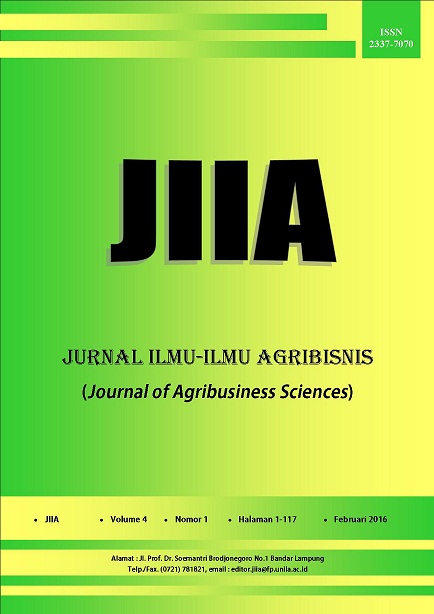SIKAP DAN KEPUASAN RUMAH TANGGA KONSUMEN TEH CELUP SARIWANGI DAN SOSRO DI BANDAR LAMPUNG
DOI:
https://doi.org/10.23960/jiia.v4i1.1216 Abstract View: 1570
Abstract View: 1570
Abstract
This study purposed to analyze the comparison consumer’s attitudes of Sariwangi and Sosro teabag to upper and lower middle class households, and the relationship between consumer’s attitudes and satisfaction of Sariwangi and Sosro teabag to households income. This study was conducted in RT 12 Sukarame Baru Village of Sukarame District and RT 07 Beringin Raya Village of Kemiling District, Bandar Lampung City. Total respondents are 60 households that consist of 30 respondents of consumers Sariwangi teabag and 30 consumers Sosro teabag. Sampling technique were using a simple cluster sampling and quota sampling. Data was taken on September until November 2014. Data was using qualitative and quantitative analysis. The results showed that the consumer’s attitudes of Sariwangi teabag are better than Sosro teabag, the consumer’s satisfaction of Sariwangi teabag are higher than Sosro teabag, and there is relationship between consumer’s attitudes and satisfaction of Sariwangi and Sosro teabag to households income.
Key words : Sariwangi teabag, Sosro teabag, attitudes, satisfaction
Downloads
Downloads
Published
How to Cite
Issue
Section
License
Authors who publish with this journal agree to the following terms:
Authors retain copyright and grant the journal right of first publication with the work simultaneously licensed under a Creative Commons Attribution License that allows others to share the work with an acknowledgement of the work's authorship and initial publication in this journal.
Authors are able to enter into separate, additional contractual arrangements for the non-exclusive distribution of the journal's published version of the work (e.g., post it to an institutional repository or publish it in a book), with an acknowledgement of its initial publication in this journal.
Authors are permitted and encouraged to post their work online (e.g., in institutional repositories or on their website) prior to and during the submission process, as it can lead to productive exchanges, as well as earlier and greater citation of published work (See The Effect of Open Access).














